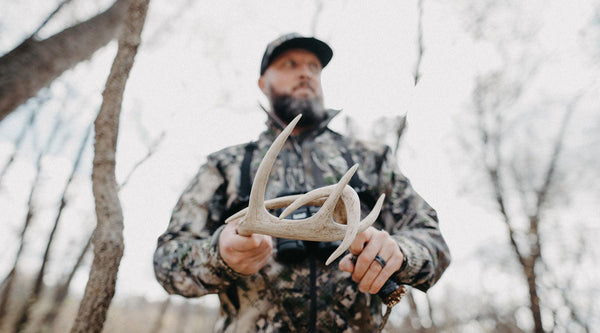Whitetail Calling Strategy
Mar 06, 2022
Using whitetail calls is not one of the most common ways to hunt whitetail, because - generally speaking - whitetail deer aren't overly vocal animals. However, there are times of the year that they do use vocalizations and you can really capitalize on that. I've had a lot of success calling whitetail, even in the South. Here's some advice I have for figuring out your whitetail calling strategy.
Whitetail Hunting Clothes
SKRE Gear® has a variety of high quality hunting clothes designed specifically with whitetail hunting in mind.
Shop Whitetail Bundles
Whitetail Calling Strategy and Scent
One thing to always keep in mind, deer want to scent check any area that they approach. Specifically mature deer. They're going to try to approach, scent check, and observe before they barrel right in, in most cases. Whether that's approaching on a feeding plot or approaching a sound.
So when you set up and you're in your tree stand or area hunting, you want to have some thicket around you. You want to have a barrier where that deer can't get downwind of you before he gets in range of your weapon and so that he can't see what he's hearing.
If you sit on the side of a field with half the field cut off by your wind and you start calling, you can almost guarantee that if a deer responds, he's going to respond downwind of you. He's going to come out in the field, he's not going to see what he heard, he's going to smell you, and it's going to be over.
So keep that basic principle in mind. If you can put your back to some kind of water or a bluff or some kind of land terrain that prevents him from getting all the way downwind of you, you can set yourself to be in a much better position to start calling.
Whitetail Calling and The Rut
When the deer are breeding - pre-rut, during the rut, and post-rut - deer use vocalizations for a lot of different reasons. An effective whitetail calling strategy really revolve around the rut. It is more about does and bucks responding and communicating with each other as well as being vulnerable. And you obviously want to key in on that to catch big bucks on their feet during the daylight.Types of Calls
Fawn Bleat
I don't personally really know a whole lot of applications or scenarios where you would use a fawn bleat. Maybe in the summertime, you could use a distress bleat.Call Cans
They also make these cans that sound like a doe bleat. That's an estrus bleat.Grunt Calls
I think the most common thing that people know about is deer grunt tubes or grunt calls. Almost every grunt call on the market nowadays has a reed on a soundboard with an O-ring. If you slide that O-ring up and down, you get different sounds from a higher pitch grunt all the way up to a bleat. And then down to a really lower pitch, like a mature type of grunt.
And there are a lot of different types of grunt tubes. This one is a wooden custom-made call from T3 Calls. And this is a Primos call. It's more of your plastic and rubber molded kind of call.
Rattling Antlers
The other thing that you find commonly in a whitetail calling strategy is rattling antlers. This is an actual set of antlers from a deer I killed. Obviously, there's synthetic kind as well.
You would use rattling antlers mostly during the pre-rut when bucks are still fighting and establishing dominance. In some cases, maybe like in the Midwest where you can see a long way, you can rattle at deer that's far off, he'll hear it and respond. But generally speaking, a lot of times you're rattling to attract deer that you haven't seen.
Choosing a brand of call
Deer - like everything else - all sound different. When choosing between different brands, I would suggest just picking a call that you like the way it sounds or maybe that mimics the sounds that you've heard in the woods in your area.Blind Whitetail Calling Strategy
The thing that I would say about blind calling is you don't want to be overly aggressive. Because you can't see the deer, you can't see how they are reacting to your calls, which makes it hard to adjust your technique if needed.I've seen a lot of people who don't want to blind call in heavily timbered areas unless they've seen a deer. If you see a deer that's 150 yards away, he's not coming in your direction and you call at him, you turn him around and get him to come your way, that's really no different than if you're in a thicker area and you're blind calling and there just so happens to be a deer 150 yards away. You just can't see him.
Whitetail Calls In The Woods
As far as grunting and bleating, they could be used throughout all different periods of the rut, for lots of different reasons. Whether it's communication or chasing, tending, and as well as bucks grunting with one another in terms of territory. Out in the woods, you're either going to hear:- Short grunts: where a buck is chasing a doe. And often he'll give a little short grunt every time his feet hit the ground.
- Long tending grunts: often used by bucks when they have a doe that’s standing ready to breed.
- Roar or growls: very aggressive. You'll see bucks doing that when they're chasing a lot of does around and when the does are not standing. Or they’ll even do that with other bucks.
- Snort-wheeze: call that bucks do to one another when they're just really pissed off and territorial.
If you hear a snort-wheeze, there are two bucks in the area. A lot of times if you see a big dominant buck on his feet and you want to turn him around, snort-wheeze at him. You're going to make him mad and he's probably going to turn around and check you out.
Whitetail calling can be extremely effective. You just have to learn when to use it and when not to use it. And the best way to do that is to try it out on your own. Call deer and see how they respond and act accordingly. But I can tell you there's not a much more exciting way to hunt whitetails than getting in the situation where a deer responds to a call. While you are setting up your strategy and getting your gear in place, make sure to check out the variety of SKRE Whitetail Bundles available.




